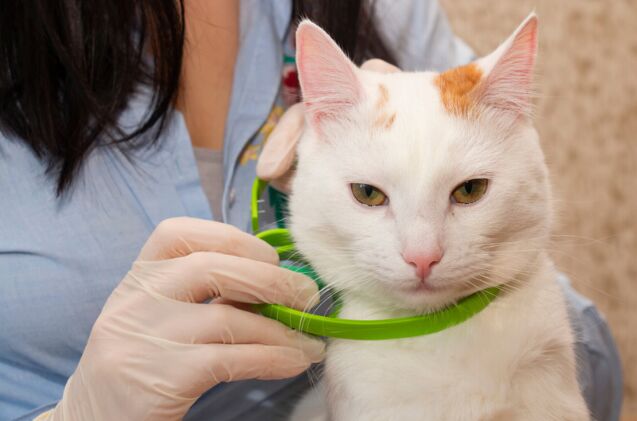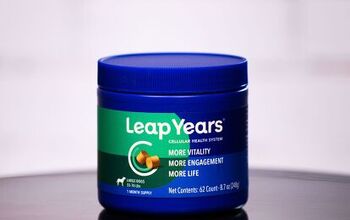Can You Use Dog Flea Products on Cats?

Are dog flea prevention products safe to use on your cat? It’s a common question for multi-pet households. If you’ve ever reached for your dog’s flea medication in a moment of pet-parent panic after seeing your cat scratching, only to hesitate at the last minute and change your mind, you’re not alone.
While the urge to banish those pesky parasites as quickly as possible is strong, using the wrong product can have serious consequences.
This post will explain why dog flea treatments are a no-go for your cat, explaining the potentially life-threatening dangers of these products and what to do if your cat has been exposed. We will also offer safe flea prevention options to keep your kitty healthy and itch-free.
Let’s get started…
Are Dog and Cat Flea Medicines the Same?
No! While dog and cat flea medicines both aim to keep fleas away from our furry friends, they use different formulas based on what is safe for each species. This means formulations designed to be more effective and safer for each species.
Many dog flea prevention products contain insecticides that are safe for dogs but highly toxic to cats. One of the most common examples is Permethrin.
This synthetic compound is often used in spot treatments, collars, sprays, shampoos, and more due to its effectiveness in paralyzing and killing fleas and ticks. But cats are unable to break down the toxins, causing them to build up and cause severe and often life-threatening internal damage.
What if I Put the Wrong Flea Medicine on My Cat?
As just mentioned, dog flea prevention can be incredibly toxic for cats. If you have accidentally applied a dog-specific product to your cat or suspect your cat may have had contact with your dog’s flea prevention, you must act quickly. This can occur even if your cat was grooming your dog after they were treated and ingested the product, which is why many products aren’t recommended, even for use on dogs with cats in the same household.
Permethrin Toxicity is fast-acting and can quickly turn life-threatening. Warning signs of toxicity include:
- Panting
- Drooling
- Vomiting
- Diarrhea
- Skin irritation
- Ear flicking or twitching
- Facial twitches
- Muscle tremors
- Loss of coordination
- Lethargy
- Hyperthermia
- Seizures
While it is less common, some cats also experience vision loss or difficulty breathing.
You must act quickly if you notice any of these symptoms in your cat. The faster you seek medical treatment, the better your cat’s chances of survival.
If toxicity occurs from accidentally applying the incorrect product, wash the area with soap and water to remove as much of it as possible from your cat’s skin and fur. This will stop them from absorbing even more of the toxic chemicals. Prevent them from licking or grooming the area.
Get your cat to your veterinarian’s office or a local emergency vet clinic as soon as possible. Permethrin toxicity will usually require hospitalization so your cat can receive IV fluids and other medical support.
While this condition is serious, the prognosis for most cats is good if they receive prompt treatment from a veterinarian.
What Dog Flea Medicine is Safe Around Cats?
If you have a multi-pet home, you may be left wondering which dog flea prevention products are safe for your pups without risking your cat’s health and safety. Depending on the type of flea prevention you prefer to use, there are several cat-safe options to choose from.
Oral treatments are a great solution as, once your dog has ingested the chew, your cat cannot come into contact with anything that may not be cat-friendly. These products are available through your veterinarian and come in different formulas for dogs of all sizes, as well as products that include protection against heartworm.
Some flea and tick sprays, both conventional and natural, are safe for cats and dogs. A favorite in our home is Flea + Tick Prevent! from Kin+Kind. Another option to consider is Wondercide Natural Flea, Tick & Mosquito Spray.
Ask your vet for recommendations that are safe to use in your multi-pet household.
However, be warned. Even a cat-safe product can be dangerous if a cat overdoses. Keep all flea-prevention products stored safely out of your cat’s reach in a closed cupboard or drawer. If you suspect your cat has gotten into a product and may have been exposed to a high level, follow the steps above for toxicity and get your cat to a vet for treatment as quickly as possible.
Do Indoor Cats Still Need Flea Treatment?
One comment we often hear from cat parents is that their cat doesn’t need flea prevention as they are an indoor-only cat. While this may seem to make sense, the theory breaks down when you consider that fleas can be carried into the home on other pets or even people.
If you are walking through a grassy area with fleas present, they are actively searching for a host. Often, these pests will jump onto your socks, shoes, or pant legs before searching for a place to “settle in,” just as they do when they jump onto a dog’s fur before crawling to the skin's surface.
When you return to the house, if you or your dog are carrying fleas and don’t realize it, they may drop off inside the home. Unfortunately for all of us, these pests have incredible survival skills. Adult fleas can live in the house for up to 100 days. Any risk of encountering fleas outdoors could be far behind you, but the problem continues to linger in your home, where they have access to your untreated cat.
Fleas can transmit several diseases to your cat, including:
- Tapeworms
- Bartonellosis
- Tularemia
- Feline Infection Anemia
- Murine Typhus
- Rickettsia
Some of these diseases are not only risky to your cat but can also be transmitted to the human members of your family. The longer fleas are present in your home, the higher the chance you will have further complications.
While this scenario is dependent on several factors all falling in line for the flea to reach your cat, it’s a very real risk that experts don’t recommend taking.
Which Flea Treatment is Best for Cats?
Now that we have established why dog flea treatment products are not a safe option for your cat (in any condition) let’s look at what you can do to keep your cat safe. The following flea prevention options include conventional products and natural treatment alternatives to help keep these nasty pests away.
Even if you choose to use a natural approach, we recommend doing so under the direction of a veterinarian. If your current vet won’t discuss the pros and cons of natural options, consider seeking a second opinion from a vet better aligned with your preferences and approach to pet parenting.
Our cats, Pippen and Jinx, are not only at risk as indoor cats, but they are also leash-trained and join us often when we head out on our local hiking trails. This increases the risk of exposure to fleas and ticks. For this reason, we prefer to use a vet-recommended convention flea prevention product combined with natural options as an added level of protection.
Topical Flea Treatments
Topical preventatives or “spot-on treatments” are products that come as liquids in small tubes. You must apply the liquid directly to your cat’s skin at the base of the neck, where it will absorb through the skin into the bloodstream. Unfortunately, application can be difficult if you have a cat that dislikes being held. But if your cat is comfortable with the treatment being applied, most products (like Advantage II or Frontline Plus for Cats) are highly effective and will last for approximately a month before needing to be reapplied, making them incredibly convenient.
Oral Flea Treatments
Do you have a cat that is a master at taking treats and medications? If so, this may be easier than using a topical treatment. Oral medications are generally tasty flavored tablets (according to our feline friends) that allow your cat to ingest the medication, releasing it internally into the bloodstream. A popular cat-safe example is Capstar Fast-Acting Oral Flea Treatment.
Flea Collars
This is an easy solution for cats that are comfortable wearing collars. Flea collars are specialized collars that contain the flea prevention medication in the collar itself, slowly releasing it to your cat’s skin at the point where it makes contact. Simply put on the collar and change it based on the timeline recommended by the manufacturer to ensure it is still active.
Flea Sprays
As we already shared above, flea sprays are available as conventional and natural treatment options. They are simply sprayed onto your cat when you enter a situation where they may be at risk, such as taking your cat for a walk outdoors or after returning home from a hike with your dog, where you may be introducing fleas inadvertently to the home. Our go-to flea spray is the Flea + Tick Prevent! from Kin+Kind.
Flea Powders
These products kill and repel fleas. Flea powders can be sprinkled directly onto your cat’s fur or used to treat areas of the home where you may be concerned about a flea infestation, like your cat’s bedding or the carpet. You can also sprinkle it along the windowsills and doorways if you are dealing with a high flea presence in your yard to keep them from entering your home.
Diatomaceous Earth
For those who prefer natural treatment options, diatomaceous earth is often recommended as a natural flea powder. However, it warrants a conversation with your vet before using it, as the substance can be incredibly irritating to your cat’s lungs, mouth, eyes, and even skin. It’s not a good solution for cats that may have respiratory problems or sensitive skin problems.
DIY Flea Solutions
Whether you’re trying to add a layer of protection on a budget or simply trust home remedies better because you have complete control over what you are exposing your cat to, there are several options for creating a flea spray at home.
One common ingredient many report is effective in repelling fleas is apple cider vinegar (ACV), as the fleas dislike its strong smell. A simple DIY flea spray is a mix of 50/50 ACV and water. Place this in a spray bottle and spritz it over your cat’s fur. Be careful when spraying near the face, as the acid in ACV can be painful if it gets into your cat’s eyes. Not only does ACV help to repel fleas, but it can also help relieve any itchiness your cat may experience while clearing up a flea infestation due to its antiseptic qualities.
Fresh lemon juice is another option that works like ACV to repel fleas. Cut one whole lemon and cover it with boiling water. Allow this to sit overnight. In the morning, strain the mixture, and you will have a safe lemon-based flea spray.
Another natural flea repellent that you may choose to use for your cat is rosemary. This can be included in a spray, but it is most often used to create a natural flea dip. To make this, steep 2 cups of fresh rosemary in boiling water for 30 minutes before straining it and throwing the herb away. Add this solution to a warm water bath and allow it to cool until the temperature is comfortable. Pour it over your cat, soaking the coat before allowing it to air dry.
Final Thoughts – Safe Flea Prevention for Cats
While flea prevention is an important step to keep your cat safe and healthy, you must ensure that the products you are purchasing are made for use on cats. Many dog flea prevention products include highly toxic chemicals to cats, making them potentially life-threatening.
If you suspect you have recently used the wrong flea treatment on your cat, wash the area immediately with soap and water to remove as much of the product as possible. Call your vet for an immediate emergency appointment or make your way to the nearest emergency clinic. These products can be lethal, and time is of the essence.
For those concerned about the risks of fleas and flea-transmitted diseases, highly effective products are available that are safe for your kitty. When shopping, read the packaging carefully to ensure it says it is made for use on cats. If you are still unsure, ask your veterinarian for recommendations.
Join the PetGuide community. Get the latest pet news and product recommendations by subscribing to our newsletter here.

Britt Kascjak is a proud pet mom, sharing her heart (and her home) with her “pack” which includes her husband John, their 2 dogs – Indiana and Lucifer – and their 2 cats – Pippen and Jinx. She has been active in the animal rescue community for over 15 years, volunteering, fostering and advocating for organizations across Canada and the US. In her free time, she enjoys traveling around the country camping, hiking, and canoeing with her pets.
More by Britt
























